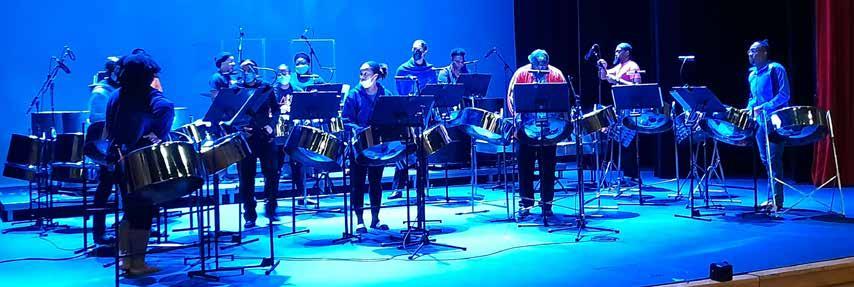
4 minute read
About the Show
from The Lydians Present: Christmas in Chrome Featuring the Lydian Steel - December 2020 - Magazine
by TheLydiansTT
Chrome: A contemplation
Human beings are always exploring the unknown. This penchant naturally turns us very often beyond the mysteries of our immediate to the oncoming. We project ourselves beyond our present, and thoughts of the future come to occupy our consciousness – so much so that “futurism” is universal in its presence across cultures… even though rarely in the similarly clothed. We project beyond a now of uncertainty, pain, loss, or despair, to a future of hope, knowledge, mastery. To a time of possibilities.
Advertisement
In the western, westernised and west-adjacent ideas of what the “future” would be, the aesthetic of it always plays an important part: “What will it look like?” is the often-voiced question. And how can it not, when people are largely, of all our senses, visual consumers.
In the 50’s-60’s the future seemed a vibrant place, colourful polymers encasing us with glass and plastic as the main aesthetics. We look at cartoons like the Jetsons, sci-fi comics of the day, and even to the Walt Disney attraction that was named “Tomorrowland,” and we are greeted with this ideation of a future of colour and clouds and lightweight transparency.
At some point, we shucked this for a future of shine and the lustre of metal; we returned to the steel of industrial revolution, but with a shinier, more polished façade. We looked to chrome – all things new and sleek and… “modern” – even changing the words we associate with the future to make it our contemporary.
Chrome: a decorative or protective finish on motor-vehicle fittings and other objects.
The Lexicographers at Oxford Dictionaries give a succinct definition of this word. Decorative or protective. The order of precedence in their choice of adjectives I would like to believe, is deliberate and may be in this same order extended to the feature instrument of this year’s Lydian Christmas offering, the Steelpan. While a now mostly standard practice, the act of putting a layer of chrome on a steelpan is a relatively new innovation to the instrument’s history – recorded as taking place in the mid 80’s with the higher ranged pans.
Now, why do we chrome a pan? The pan certainly functions without chroming, and while somewhat standard now, it is not an innovation that is a necessity. In this regard I find the “Oxford order” instructive. The shiny chroming, a treatment of nickel and chromium, gives a bright lustre. a beautiful finish that attracts the eye and gives more presence to the pan, it also lends protection to the instrument, staving off corrosion – while making the tones brighter.
Now, this act of “chroming” is far from new in musical circles; indeed Flautists will proudly tell you that their nickel, tine, silver and rose-gold cylinders evolved from wooden predecessors. More than just easier to mechanise a metallic process of creation, this innovation marks a standardisation of colour and range; of making music that much more universal and accessible. At a reach one could argue this act was protecting interest in the music by making it more accessible to reproduce.
But spare a thought for what the pan has become through this. There is now a modern acoustic instrument, created from industrial material, and played percussively, but can subsume colours from the wind, string, and percussion timbres in an orchestra.
Pan is future and the future is Pan. But I am telling you nothing you do not already know. So now, the Modern sensibility of a Christmas in Chrome.
Chroma: purity or intensity of colour.
Chromatic: of, relating to, or giving all the tones of the chromatic scale; of or relating to colour or colour phenomena or sensations
In this time of mass uncertainty, where we face the ravages and losses of and during a worldwide pandemic, the attempts of selfish men who would wield power to their own ends at the expense of the collective good, as well as the shift to accommodate a new normal in the hopes of ‘riding out the storm,’ we once again turn to time and the future as comforts and sources of hope. When our present is so fraught, we look ahead and say, “if I/ we can just make it to ____ then maybe it will be alright.” And what better season to project to at this time, than Christmas? What better space than the time of year when goodwill is an expectation and not an exception, when we
believe in hearts changing and people embracing love and harmony (though unfortunately not each other at this time) We look to the bright lights and beautiful sounds of the season, and hope that this infusion of hope takes us that much closer to a future of touch, of hugs, of laughter and shared spaces. Closer to the feeling of physical connection, not with the intermediary of our screens, and our masks and our chrome. ‘til then, may the peals of our silvery song remind all of “Peace on Earth, goodwill to men.”
Carl-Anthony Hines
Photo Credit: Kyle Stephen












